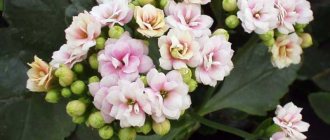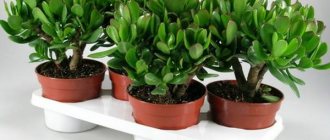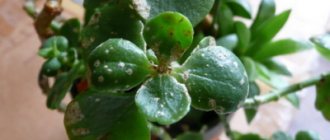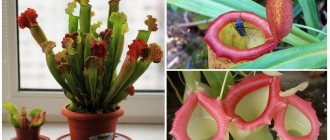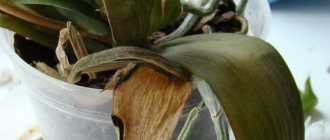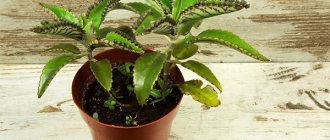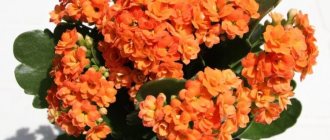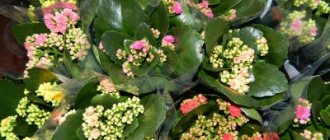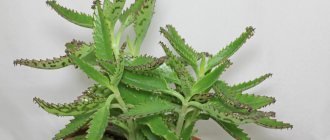How to revive Kalanchoe: saving the flower from drying out and rotting
Kalanchoe is considered one of the most unpretentious indoor plants, but due to certain circumstances, even it is not immune from troubles.
Diseases or errors in care can significantly spoil the appearance of a flower and even destroy it. Today we want to tell you how to reanimate a Kalanchoe depending on what happened to it. So, most often the following problems arise with a beautiful blooming flower:
- the foliage dries and falls off;
- leaves wither and lose turgor.
Causes of drying and falling leaves
During the heating season, the tips of Kalanchoe leaves often dry out.
This is due to low air humidity, which the plant does not tolerate well. It is necessary to keep the pot away from the radiator and fireplace. If the leaves begin to turn yellow and crumble, the bush does not have enough nutrition. From late spring to early autumn it needs to be fed with mineral complexes for succulents. In this case, use a concentration 2 times lower than the recommended one.
Foliage also dries out due to too bright lighting. In summer, the best place for Kalanchoe is an eastern window.
Late timing and errors in pruning and replanting
Young bushes need to be replanted annually.
Adult Kalanchoe is transplanted into fresh soil every 2-3 years. If replanting is not done or done very rarely, the soil in the pot is greatly depleted and the plant lacks nutrients. Even regular feeding does not help. The lower leaves on the branches turn yellow and crumble, the shoots become bare. Particular attention should be paid to pruning the plant. Only a properly formed bush will delight you with beautiful, large and green leaves.
If the plant is not pruned, the old leaves will gradually turn yellow and fall off. This is a natural process, but if the shoots are not rejuvenated by pruning, they become very elongated and unattractively exposed.
How to revive Kalanchoe with limp leaves
A healthy plant has leaves that are hard and elastic and grow almost perpendicular to the stem. If they become limp, sagging and begin to crumble, this may indicate that:
- The soil in the pot is too dry. Even succulents cannot go without water for a long time, especially young bushes. At first they make do with their own, albeit small, forces, but when the moisture reserves are depleted, the flower begins to fade. You urgently need to water the plant, but without fanaticism - everything that flows into the pan must be drained. The very next day the leaves will again be hard and sticking out to the sides.
- The flower was caught in a draft or the temperature in the room dropped sharply. Although Kalanchoe does not particularly like heat and sun, it does not like low temperatures and cold air flows. Move the pot to a window that does not open, and after a while the bush will restore turgor.
- The root system is rotten. The reason for this is definitely excess moisture. Constantly wet soil for a flower means death, because putrefactive processes actively begin to develop in the soil. First the roots rot, then the above-ground part suffers. The leaves will become limp, spots may appear on them, and over time even massive leaf fall will begin. Such a bush can only be saved by replanting and thorough cleaning. All parts of the plant infected with rot should be cut off, get rid of the old soil and plant in fresh substrate. To prevent further development of rot, the plant must be treated with a fungicide.
If the Kalanchoe is affected by root rot and the disease has already appeared as spots on the leaves, it is better not to risk it and throw it away. If possible, you can root a healthy apical cutting, which the fungus has not yet reached, but also treat it with a fungicide.
Soil depletion, improper fertilizing
In the absence of replanting, the root system grows and becomes cramped in the old pot. In addition, there is a gradual depletion of the soil, as a result of which the Kalanchoe begins to experience a deficiency of nutrients. At the same time, the growth of the flower stops, the leaves become smaller and turn yellow.
Young bushes are replanted annually, the soil in the pots of adult plants is changed every 2 years. If the Kalanchoe is still actively growing, choose a planting container 1.5-2 cm wider and deeper than the previous one.
It is advisable to take a purchased soil mixture intended for succulents, since it has a balanced composition. The drainage layer is made from any suitable material (pebbles, expanded clay, brick chips) in a layer of at least 1/5-1/4 of the depth of the pot.
Succulents are sensitive not only to deficiency, but also to excess of nutrients, so they are fed very carefully. Fertilize mainly flowering species from late spring to early autumn
Fertilizing is carried out no more than 2 times a month with compounds for succulent plants. The concentration of the solution is made 2 times weaker than recommended in the instructions.
Why does it wither
Kalanchoe is a succulent plant and therefore very easy to care for. But if the care is not correct, some problems may begin. For example, the flower will take on an unsightly appearance and will have limp leaves. They will be soft in consistency, and if nothing is done, the leaves will soon fall off.
The following points can lead to such a situation:
- overwatering the plant. Kalanchoe is capable of accumulating water to some extent in its leaves. That’s why they look fleshy and dense near the flower. And if you flood the plant, the leaves will begin to fall;
- insufficient watering. Of course, Kalanchoe can remain without water for some time (even an earthen crust may appear in the pot), but if watering is insufficient, the leaves will dry out. During prolonged drought they fall off;
- water indicators. “House Doctor” should be watered with settled and soft water. Otherwise, various diseases and other manifestations of poor health of the flower may appear;
- light mode. For some varieties of Kalanchoe, a negative factor for growing at home is exposure to direct sunlight on the leaves. In this case, the leaves may curl and brown spots appear on them, which indicate that the leaf blade has been sunburned;
- temperature regime. When the wrong temperature regime is created, the leaves of the plant also begin to dry out and fall off.
It is very important to properly monitor the flower during the dormant period and in winter. In this situation, even slight fluctuations in the parameters described above can lead to the leaves beginning to fall and the plant itself to become sick.
Diseases
If improperly cared for at home, Kalanchoe becomes susceptible to various types of diseases. External manifestations of flower disease can be different. If this plant is sick, black spots and even mold may appear on its leaves. At the beginning, the spots will be small, and then they will begin to increase in size. The appearance of spots on the leaves indicates that the Kalanchoe has been infected by a fungus. To get rid of it, it is necessary to completely spray the plant with fungicides.
The main reason for the appearance of fungus and black spots is severe waterlogging of the soil, as well as a violation of its aeration. Therefore, it is not enough to simply spray the flower with fungicides; you also need to transplant the plant into another pot with new soil.
In addition, brown spots may appear on the leaf blade. Their appearance indicates the presence of a disease called Dropsy. It develops with a combination of waterlogging and temperature changes. To get rid of this disease, you need to move the pot to a drier and warmer place, and also reduce the number of waterings. Sometimes you can notice a white coating on the plant. This means that watering was carried out with too hard water with a high content of lime and salts.
Kalanchoe, in addition to the conditions described above, can also be subject to the following diseases:
- late blight rot. When it occurs, brown spots form on the leaves. The reason for the appearance is poor ventilation, temperature changes between the soil and air, or excessive watering. To combat the pathogen, you need to eliminate negative influencing factors and treat the flower with fungicides;
- gray rot. As this disease develops, weeping spots appear on the stems and leaves, which are always covered with a gray coating. The main reasons for the appearance are excess moisture, insufficient light conditions and poor ventilation. The means of control are the same as for late blight rot;
- powdery mildew. This disease manifests itself in the form of white spots with a powdery coating. Outwardly, they resemble mold. As a result of this disease, leaves fall from the stems. The causes of the disease are considered to be high air temperature and low humidity.
As you can see, improper care of the “house doctor” can lead to its infection with fungal microorganisms and treatment will be required to avoid death.
Basic succulent diseases and home therapy
Kalanchoe, like any plant, is susceptible to various diseases
It is important to identify the disease in time and begin treatment so that the flower does not die
Late blight
The disease actively affects garden and vegetable plants, but indoor flowers are also not immune to this problem. It is characterized by the appearance of brown spots on the leaves, which gradually turn black. After some time, the disease spreads throughout all the branches and stem, they become soft and rot.
Note! Late blight very quickly affects the entire flower. If the root system of Kalanchoe is diseased, you can easily remove it from the pot.
Late blight is caused by improper and irregular watering, stagnation of moisture in the pot, and unsuitable and too dense soil. Often such a disease is caused by irrigation with rainwater.
It is possible to cope with the disease. To do this, remove all affected leaves and treat the sections with activated carbon. It is best to transplant the plant into a new pot, after irrigating it with a solution of potassium permanganate (1.5 g per 5 liters of water). Specific antifungal agents will help well.
Powdery mildew on Kalanchoe
Powdery mildew often appears on flowers located next to each other in a warm and humid room. A coating on the leaves is noticeable on Kalanchoe. When the temperature drops, the fungus will die, but the plant will not be cured. The leaves will gradually curl and fall off, and the succulent will bloom poorly and little.
For your information! Infection often occurs from one flower to another with the help of water and wind
Therefore, care must be taken when spraying plants.
Many people are interested in what to do if there is a white coating on the leaves of Kalanchoe. Treatment consists of complete control of watering; irrigation is carried out only at the root; moisture should not fall on the leaf blades and stem. The pot is moved to another place, providing the Kalanchoe with more air and space. Be sure to treat with specific fungicides to kill the fungus.
Powdery mildew on succulents occurs due to waterlogging
Stem rot
The cause of this disease is a sharp drop in air temperature. When affected, the plant experiences blackening of the stem and leaves, softness and rotting of all parts.
The main treatment is to create optimal conditions for growth and development for Kalanchoe. The normal temperature for a flower is 15-20 °C in winter.
It is worth remembering that at low temperatures there should be no frequent watering to avoid rotting of the root system.
Gray rot
A similar disease affects indoor flowers quite often. The fungus quickly spreads to all parts of the plant. The presence of white dust located in small piles is noticeable on the leaves. There are brown water spots on the stem. All parts of the plant located above the site of damage die off.
Gray rot often appears due to irregular and improper watering. Constant stagnation of moisture provokes the development of the disease. It is imperative to remove fallen leaves from the pot to prevent fungal diseases.
Treatment is carried out with special fungicidal preparations, treating the plant twice with a break of 2 weeks. Solutions are prepared according to instructions.
Gray rot can destroy a flower in a matter of days
Ring spot
The disease is manifested by the formation of small spots on leaf blades. At the first stage they are yellowed, gradually turning brown. The disease takes a very long time to develop. At first the spots are small, but gradually they merge into one large one. Leaves may turn yellow, dry out and fall off.
Important! Ring spot is caused by a fungus. It is recommended to carefully control the watering of Kalanchoe, pour water only at the root and make sure that it does not stagnate.
It is recommended to treat with special preparations; the pot is moved to a more spacious place.
In most cases, Kalanchoe diseases are caused by fungi that love high humidity.
Therefore, it is important to irrigate the flower regularly, but make sure that there is no excess moisture.
Pests
Kalanchoe is often grown at home and is rarely attacked by pests. But if care is improper, the plant can become a reservoir for harmful insects.
The parasites of this flower are the following insects:
Let's look at each pest in more detail.
Aphids are the most dangerous enemy for Kalanchoe. Aphids are small greenish-black sucking insects. It initially lives on the underside of the leaf and eventually spreads throughout the plant. In the presence of such a pest, the leaves begin to lighten and become sticky to the touch. This is the result of the action of aphids, which secrete a toxic substance. In this case, Kalanchoe does not bloom, and the buds that appear wither and fall off.
The danger of infecting flowers with this particular insect is that the aphid becomes a carrier of many viruses and creates optimal conditions for the development of the fungus. The fight against it involves destruction by burning the affected stems and leaves, as well as treating healthy parts with an insecticide. It will not be possible to destroy aphids in one go. A minimum of 4 treatments are required at one week intervals.
Scale insect and false scale insect
Scale insects belong to the suborder Coccidae and are insects with an oblong two-millimeter body, which is covered on top with a waxy shield. Females are much larger than males and have neither wings nor legs. They sit motionless, covering their eggs. A plant affected by scale insects is covered with a peculiar coating of insects.
The leaves begin to turn yellow and fall off, the growth of Kalanchoe slows down, and flowering stops. The condition of the plant worsens due to additional damage from sooty fungus, which multiplies in the sticky secretion secreted by scale insects. Pests stay mainly on the underside of leaves. Only young larvae are capable of movement; adults are immobile.
To prevent this disease, the plant must be examined regularly and carefully. And at the end of winter and at the beginning of spring, make sure that the Kalanchoe is in a well-ventilated area. If the air temperature allows, spray the plant with water more often - scale insects do not like a humid environment.
Ways to combat scale insects
Insects must be collected from the leaves, and then the flower must be washed with soapy water. To make scale insects easier to remove, they are pre-treated with alcohol. There are no special insecticides to combat scale insects, so you can use any preparation intended for indoor plants.
You can fight pests using folk remedies - regularly (3-4 times a week) wipe the plant with a cotton swab dipped in vodka or diluted alcohol. Remove scale insects using an old toothbrush. You can also wash the plant with garlic infusion. Grind 5-6 cloves of garlic in a mortar and add a glass of water. Infuse the resulting mixture in a dark place for several hours, filter it and spray the plant.
Why do Kalanchoe leaves dry and wither?
But, despite the simplicity of caring for Kalanchoe, some problems with the flower may still arise. Many people wonder why the leaves turn yellow and dry, wither or curl and other similar questions. The reasons for this may lie in the natural processes of the plant’s life cycle or improper care or replanting, plant diseases, pests, insufficient nutrients in the soil, or vice versa. Why Kalanchoe dries - this is what we will talk about in this article.
One of the most common problems faced by housewives of all types of Kalanchoe is the yellowing leaves of the flower. Leaves may turn yellow in different parts of the plant, which indicates different reasons for this process.
If the leaves turn yellow only on top, but remain green below and fall off, then the problem is not enough light. If the leaves begin to turn yellow evenly along the entire length of the stem, then most likely, on the contrary, the flower is receiving too much direct sunlight and should be moved to partial shade.
If the lower leaves turn yellow and dry out, this may indicate that the soil is drying out. Also, the lower leaves may fall off due to too dry warm air. This process occurs especially often in winter due to dry air. Then the flower pot should be removed away from the central heating radiators. The ideal air temperature for Kalanchoe during the winter dormant period is 13-15 degrees. In the summer, due to extreme heat, its leaves may turn red, so at this time all pots with plants should be removed from areas of direct sun exposure to partial shade.
Also, the plant can stretch in length and shed its lower leaves for the following reasons:
- lack of lighting;
- excessive moisture;
- aging of a flower as a natural process.
If the plant is more than a year old, it may need rejuvenation. This procedure is carried out in the spring.
How to solve the problem of stem stretching? In fact, it’s easier to renew a flower by transplanting its stems into a new pot and then taking care of it more carefully so that it retains its freshness and lushness longer. What you need to do for this:
- trim leaves with children so that they do not take part of the energy and nutrients;
- periodically pinch off the top leaves so that the Kalanchoe grows not only upward, but also in width;
- in summer or spring at the end of the season, you can carry out the procedure of pinching the tops to form side pagons;
- place the flower in a bright place, but so that the direct rays of the sun do not fall on it;
- in winter, move the pot to a south window and, if possible, give it additional “light” using fluorescent lamps;
The volume of the pot also plays an important role. The lower leaves may fall off simply because the flower is too cramped in the pot.
Also, not only the leaves, but also the stem itself can dry out. In this case, there is a high probability that parasites live in the root system of the flower and absorb all the moisture from the central stem.
You can often see brown tips on the leaves that look like they have dried out or burned. What could be the reasons and how to fix this problem:
How to determine the cause of the problem with leaves and what to do?
Brown spots
The appearance of brown spots on the plant occurs mainly in the summer, especially during hot weather. The cause of this disease is lack of moisture.
To solve this problem, proper watering of Kalanchoe is required.:
- Watering must be carried out immediately after the top layer of soil dries;
- the amount of water for irrigation should be sufficient.
Black (dark) spots
The appearance of black or dark-colored spots on Kalanchoe leaves indicates they are infected with fungus or mold. The reproduction of a fungus similar to black mold is carried out by an insect that feeds on the sap of Kalanchoe - the mealybug. If measures are not taken, the plant may die.
The reason for this is excessive watering, due to which the soil simply does not have time to dry out and the supply of air oxygen is limited. The situation can also be aggravated by low air temperature in the room - coolness and humidity are an ideal environment for the development and habitat of mealybugs .
To eliminate this defect, a number of measures are required:
- Change the soil to a more loosened one.
The leaves turn yellow
Yellowed leaves on Kalanchoe can be seen both in summer and winter.
In summer, this is due to the high influence of sunlight and dry air ; in winter, on the contrary, the flower may suffer from a lack of natural light.
To eliminate the causes of yellowing of the deciduous part of the plant, it needs to organize proper care:
- In winter, do not feed the flower, only during the growing season - no more than twice a month.
Are twisting
The leaves may curl without changing color , and sometimes with a change in burgundy color.
The first phenomenon in most cases is caused by damage to the root system. Usually its damage occurs due to excessive watering: the root begins to partially rot from excess moisture.
A change in color indicates that the plant has been in direct sunlight for a long time.
To eliminate the consequences of damage to the root system, it is recommended:
- inspect the roots of Kalanchoe for damaged parts;
- cut out dead areas, and rinse healthy ones in a weak solution of potassium permanganate to wash away pathogenic microflora;
- additionally treat root sections with charcoal powder;
- Plant the treated plant in new soil.
Fall off
The plant often sheds its leaves due to improper maintenance in winter . The reason for this phenomenon is the presence of the flower in a room with a high temperature or next to a heating radiator.
The solution will be to provide a more favorable climate for the plant - the temperature in the room should remain between 15-20ºC.
Wither
A flower can fade both at a young and adult age.
- At a young age, the cause of wilting may be insufficient or irregular watering (for example, not watering the plant for a week, and then filling the pot full). Under such conditions, the root may rot, and water will not flow into the leaf part, but will begin to accumulate in the soil.
- Adult Kalanchoe , in turn, fades due to aging. Alas, a Kalanchoe with a rotten root cannot be saved, just remember that it requires regular and light watering. But it is still possible to give new life to an old plant - you need to separate the cuttings and plant it again.
Covered with white coating
The appearance of a white coating on the leaves of Kalanchoe does not occur immediately, so it is impossible to immediately notice the painful state of the plant.
The only way to prevent this problem is to soften hard water. To water plants, it is recommended to let the water sit for three days and then filter it from impurities.
